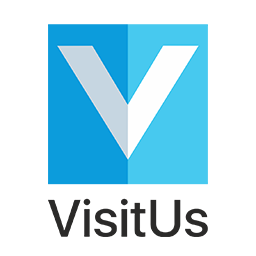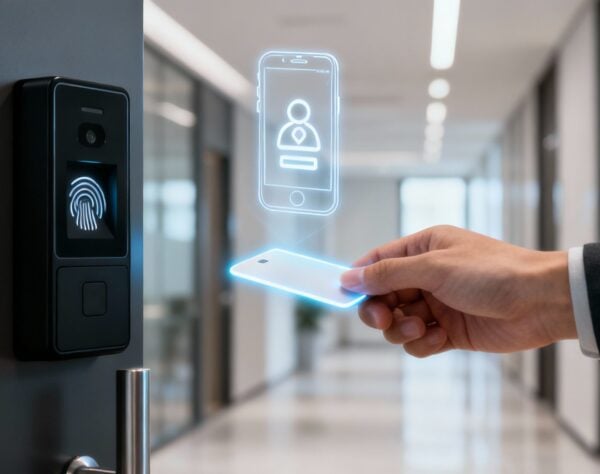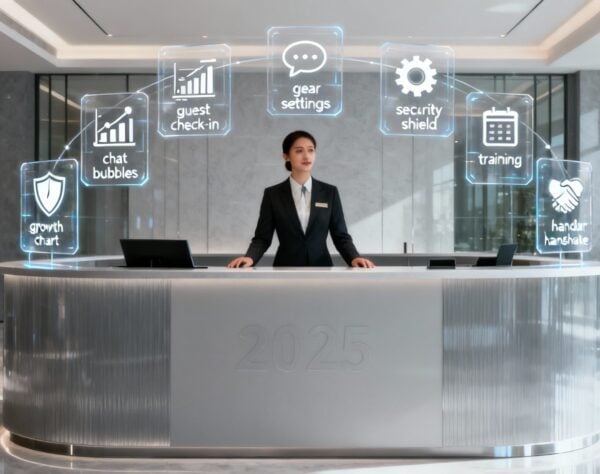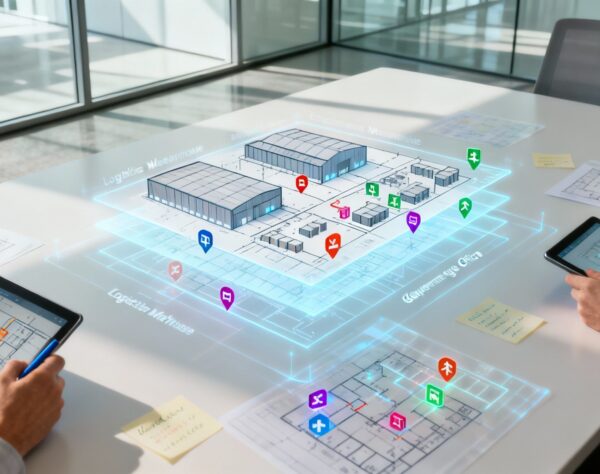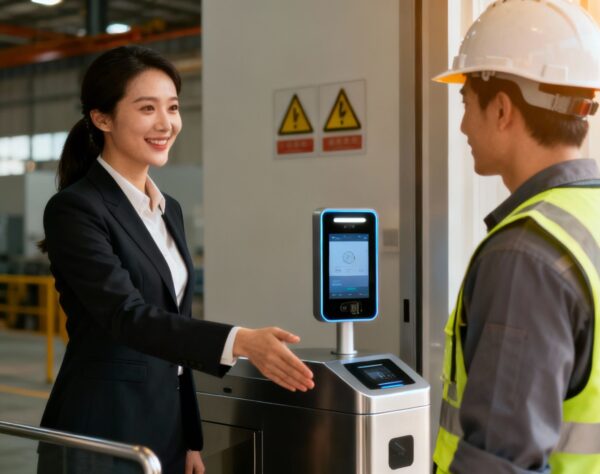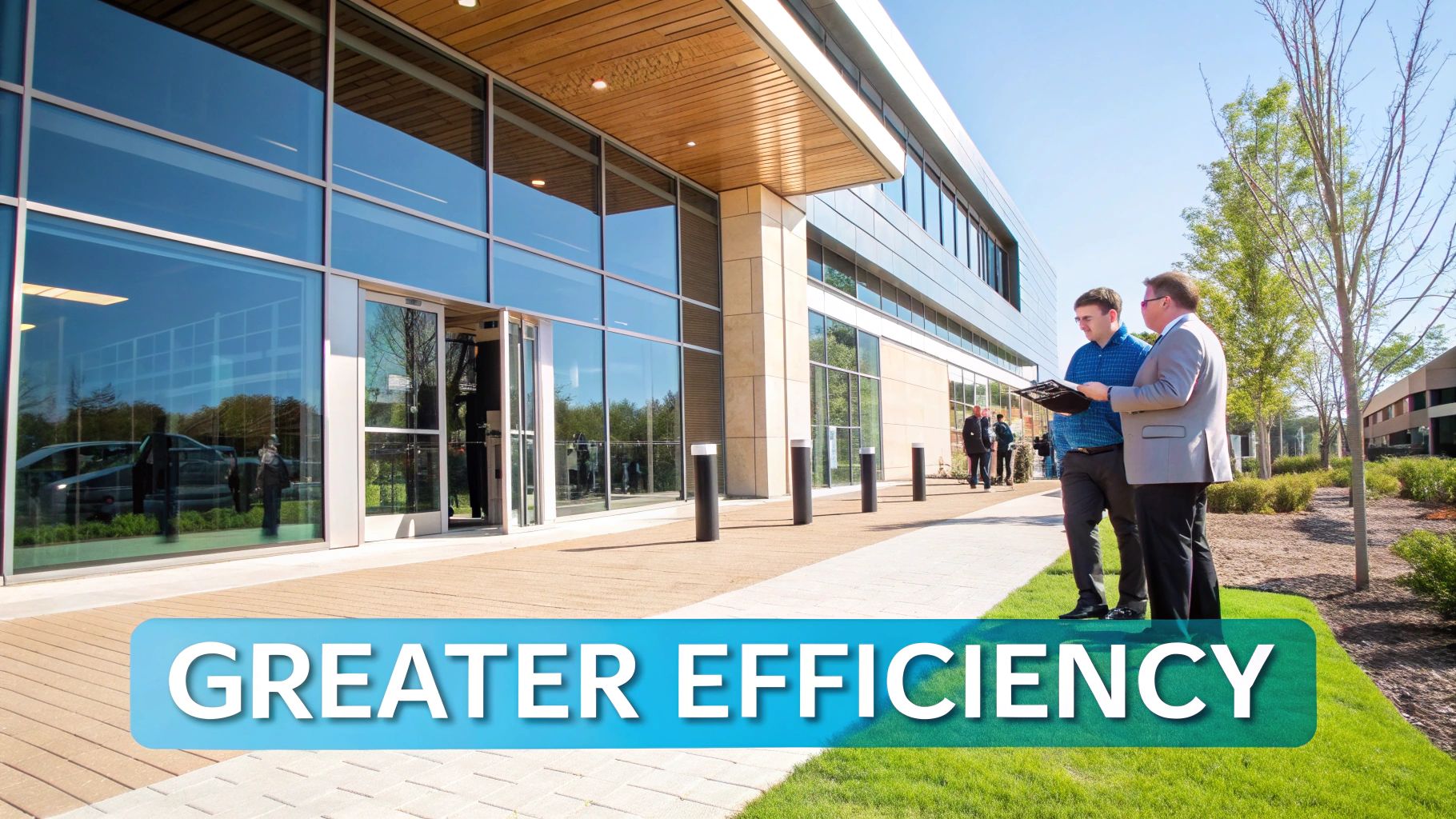
The Ultimate Guide to Facility Management Applications
Facility management applications are the digital command centers transforming how modern buildings operate. They replace the manual, often chaotic, tasks of running a facility—from maintenance calls to visitor check-ins—with intelligent, automated systems.
Think of it this way: these applications are the central nervous system for your entire building. They are what separate a team constantly reacting to problems from one proactively managing a building's entire lifecycle for peak performance. A startling 80% of facility managers agree that technology is crucial for achieving their operational goals.
From Clipboards To The Cloud: The Modern FM Revolution
Remember the old days of facility management? It was a world of overflowing filing cabinets, frantic radio calls, and a spiderweb of complex spreadsheets. This reactive, "firefighting" approach meant managers spent their days chasing problems instead of preventing them, leading to lost paperwork, delayed maintenance, and decisions based on little more than a gut feeling.
That world is quickly disappearing. The shift to modern facility management applications isn't just a trend; it's a fundamental change driven by the need for smarter, more efficient buildings. Companies using these applications report up to a 20% increase in labor productivity by eliminating manual processes.
The best analogy is moving from a foldable paper map to a live GPS. The map gives you a static, outdated picture of the road. A GPS, on the other hand, gives you real-time traffic updates, automatically reroutes you around accidents, and always shows you the most efficient path forward. That's what this software does for a building.
The Problem With The Past
Without a central system, critical information was scattered everywhere—on a clipboard in a maintenance truck, buried in a forgotten spreadsheet, or locked away in someone's memory. This created massive bottlenecks and inefficiencies.
- Delayed Responses: A broken HVAC unit would trigger a long chain of phone calls and manual scheduling, leading to extended downtime and unhappy occupants. This inefficiency can increase repair times by over 35%.
- Wasted Resources: Without data, teams often wasted labor hours and ran up operational costs on tasks that weren't urgent.
- Lack of Foresight: Decisions were almost entirely reactive. It was nearly impossible to predict when equipment might fail or how to optimize energy use over time.
This old model simply can't keep up with today's complex buildings. As these applications power the modern FM revolution, it's worth looking at the top smart office trends that are shaping how we work.
To really see the difference, let’s compare the old way of doing things with the new, software-driven approach.
Traditional vs Modern Facility Management
| Area of Operation | Traditional Method (The Past) | Modern Application (The Future) |
|---|---|---|
| Work Orders | Paper forms, radio calls, word-of-mouth | Automated digital requests, mobile assignments |
| Maintenance | Reactive; fix things when they break | Proactive & predictive; schedule based on data |
| Data & Reporting | Manual spreadsheets, gut-feel decisions | Real-time dashboards, automated reports |
| Asset Tracking | Manual logs, physical tags, often lost | Centralized digital inventory, QR/NFC tags |
| Communication | Phone calls, emails, disconnected channels | Integrated messaging, instant notifications |
| Energy Management | Manual meter readings, estimated usage | Smart meters, IoT sensors, automated optimization |
This table makes it clear: the shift is from fragmented, manual guesswork to a unified, intelligent system that provides complete visibility and control.
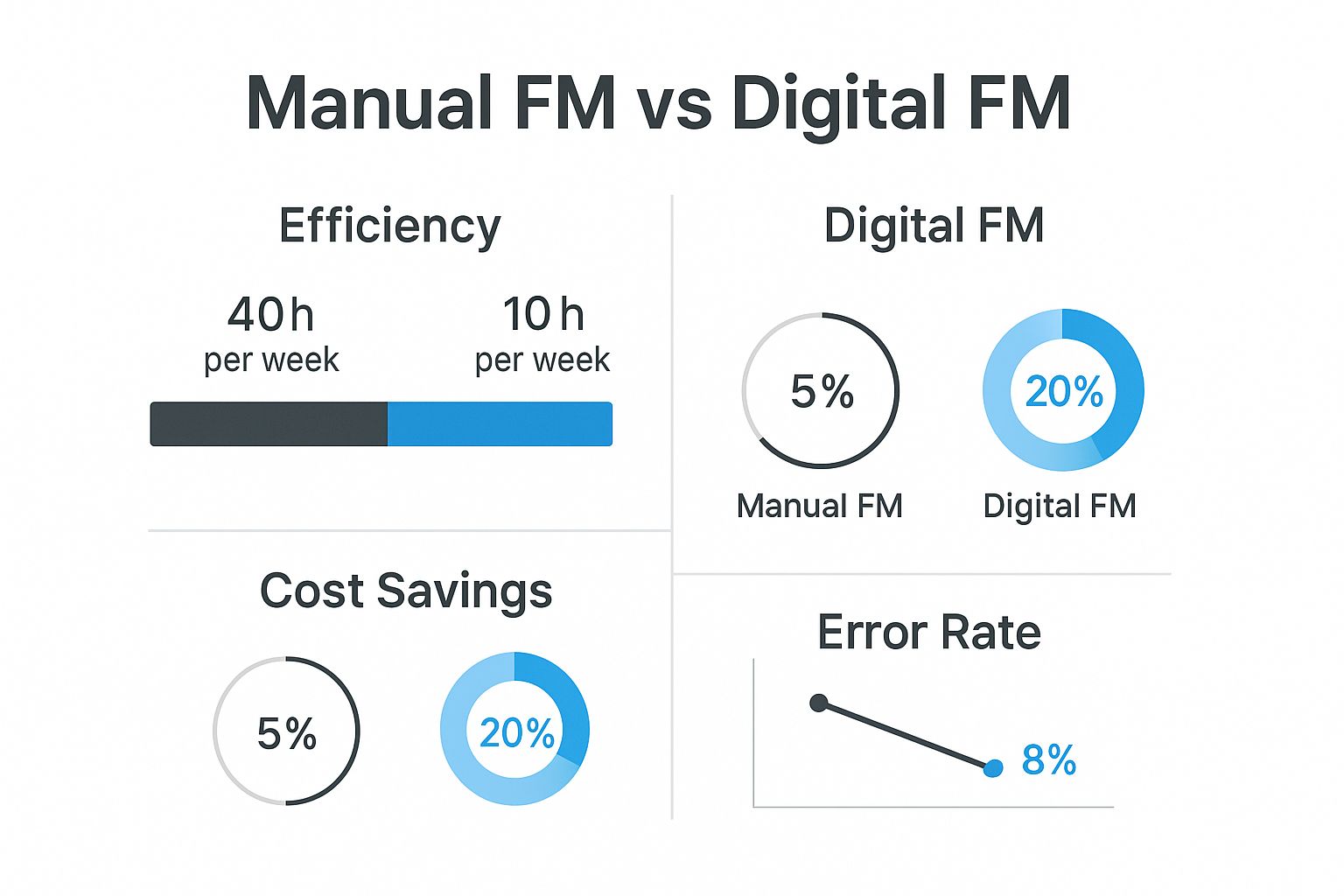
The numbers don't lie. Digital tools can slash administrative hours by up to 40% and dramatically reduce error rates, proving their direct impact on the bottom line.
This digital shift isn’t just about convenience. It’s a strategic move that’s essential for staying competitive. Modern applications give you the visibility and control needed to turn your facilities from a cost center into a genuine strategic asset.
This transformation is fueling incredible industry growth. The global facility management market was valued at an estimated USD 1.46 trillion in 2024 and is expected to soar to USD 2.38 trillion by 2034. This boom is directly tied to the rapid pace of construction and urbanization worldwide, highlighting just how critical technology has become in managing the built environment.
What Exactly Are Facility Management Applications?
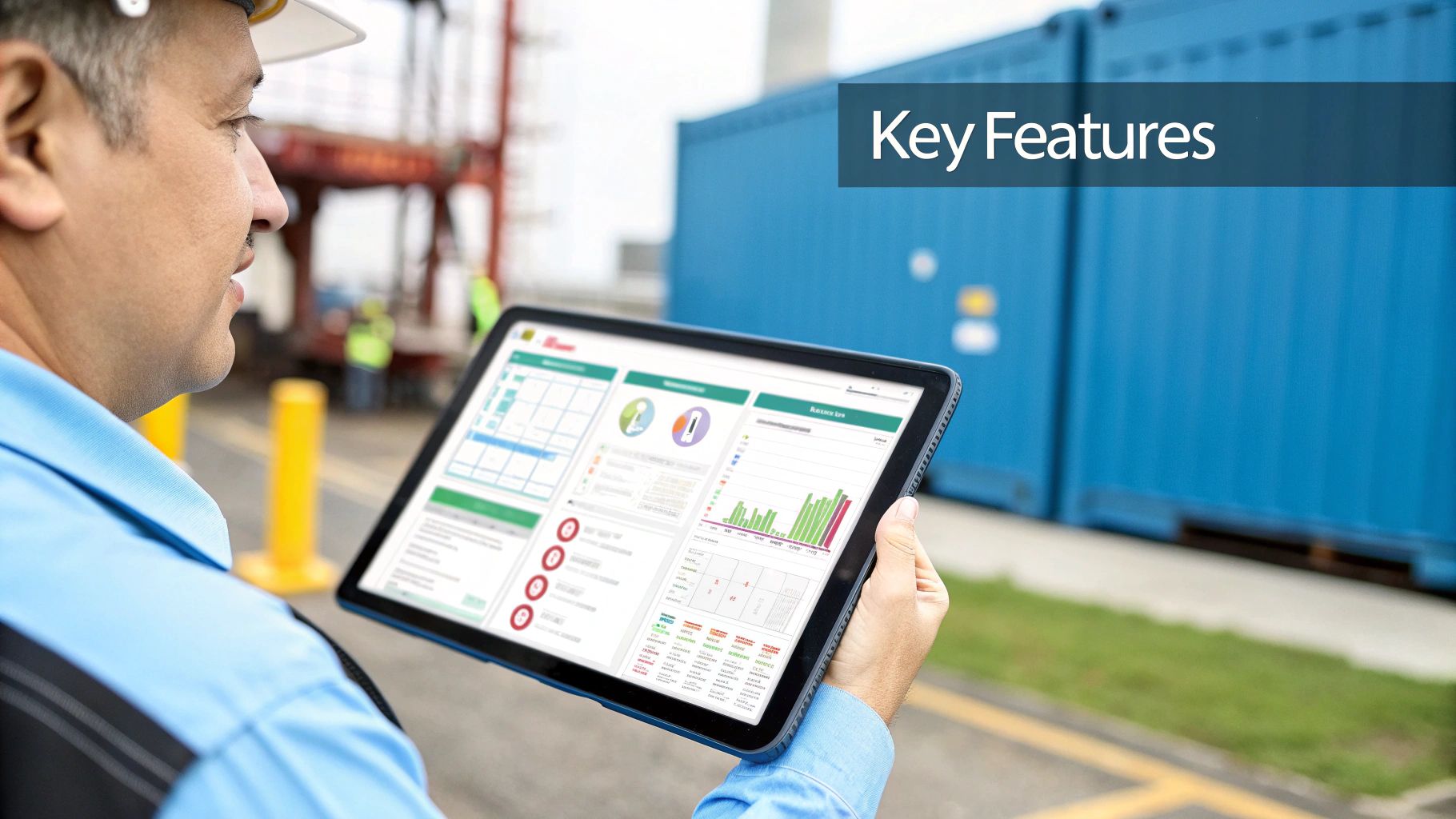
Let's cut through the jargon. At its heart, a facility management application is the digital command center for your building or entire campus. It’s a smart system that handles tedious tasks, centralizes critical information, and optimizes how you manage your physical space and assets.
Instead of getting lost in spreadsheets and emails, these platforms give managers a single dashboard to see everything. This shift changes the job entirely—you go from constantly putting out fires to strategically preventing them. For instance, 78% of businesses using these applications report improved long-term strategic planning.
This digital-first approach is exactly why the global facility management software market is booming. It was valued at USD 3.79 billion in 2024 and is expected to more than double to USD 9.60 billion by 2033 as more businesses swap their old manual ways for smarter, automated systems.
From Alphabet Soup to Clear Solutions
The world of facility management loves its acronyms—CMMS, CAFM, IWMS. It can feel like alphabet soup, but each one is just a label for a tool designed to solve specific problems.
-
CMMS (Computerized Maintenance Management System): This is the workhorse for your maintenance crew. Its main job is to transform your maintenance from reactive chaos into a proactive, scheduled operation. It ensures equipment gets serviced before it breaks, which makes your assets last longer and slashes those expensive emergency repair bills.
-
CAFM (Computer-Aided Facility Management): This system takes a broader view by adding space management to the mix. It helps you see exactly how your physical space is being used, so you can stop paying for empty offices or poorly laid-out floors.
-
IWMS (Integrated Workplace Management System): This is the all-in-one solution. It bundles everything from a CMMS and CAFM and then adds tools for project management, sustainability tracking, and real estate planning. It acts as the single source of truth for the entire workplace.
On top of this, many facility management applications integrate with sophisticated Building Energy Management Systems (BEMS) to give you precise control over your building’s energy use. This is a game-changer for hitting sustainability targets and cutting down on utility costs.
The Real-World Benefits in Action
It’s one thing to talk about systems, but it's another to see what they actually do. Imagine a huge manufacturing plant. Instead of a manager walking the floor and guessing which machine might be next to fail, the application flags a motor that’s vibrating just a little too much.
A work order is instantly created and zapped to a technician's tablet—complete with the machine’s service history and a list of parts needed. The fix is done during a planned maintenance window, avoiding a massive breakdown that could have shut down the entire production line for hours. This proactive approach can reduce equipment downtime by up to 50%.
The ultimate benefit isn't the software itself, but the power it gives you to make smarter, faster, and more cost-effective decisions. It shifts the focus from "what is broken?" to "how can we operate better?"
This proactive mindset goes way beyond just maintenance. It touches every part of the facility. For example, enhancing building security and creating a positive guest experience are vital for modern operations. A visitor management system is a key part of this strategy, providing benefits like improved compliance and a seamless, professional welcome for every guest.
The True ROI of Smart Facility Management
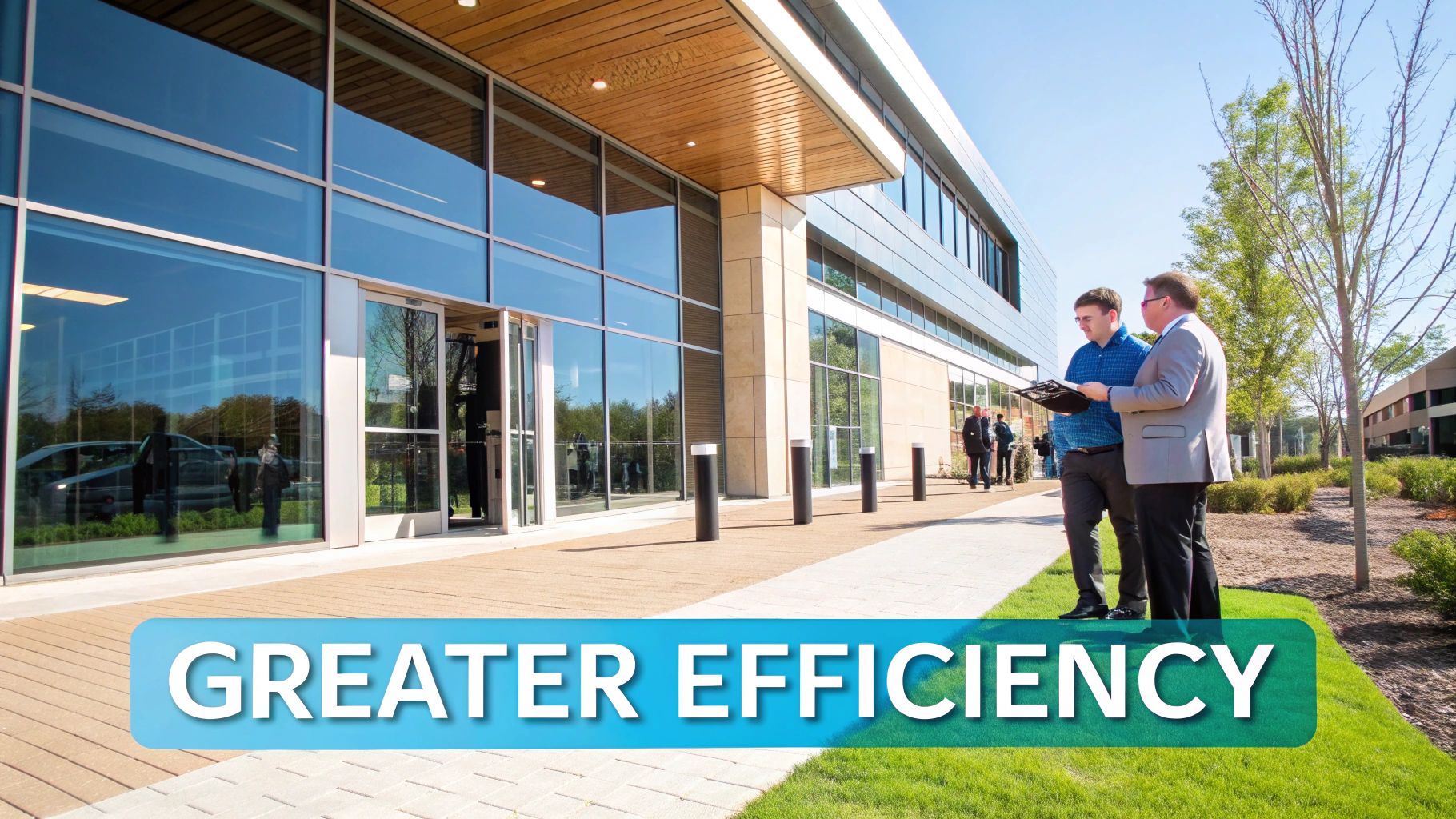
When you invest in a facility management application, you’re not just buying another piece of software. You're making a strategic move to unlock real financial and operational returns. The true value lies in how these tools solve business problems and turn your buildings into high-performing assets.
Ultimately, the return on investment (ROI) shows up in three key areas: lower costs, higher productivity, and a much safer, more compliant workplace. The software becomes a partner that helps your team work smarter, not harder.
Driving Down Costs with Data
One of the first places you'll see a big impact is in your operational budget. This is about a fundamental shift in how you handle maintenance and energy.
Predictive maintenance uses data to see equipment failures coming. This lets you schedule service during planned downtime, a simple change that can slash equipment breakdowns by up to 70%. That foresight doesn't just cut down on emergency repair bills; it also extends the life of your most critical machinery, pushing back massive replacement costs.
Energy optimization is another goldmine. A smart facility app can plug directly into your building's systems, monitoring and adjusting energy use in real time. By automating HVAC and lighting based on when people are actually in the building, facilities can trim their energy bills by as much as 30%.
A facility management application transforms maintenance from a reactive expense into a proactive investment. By catching issues early and optimizing energy use, it directly protects your bottom line and frees up capital for growth-focused initiatives.
Boosting Productivity Across the Board
The productivity gains are a two-for-one deal, helping both your facility management team and everyone else in the building. For your FM crew, automation gets rid of the soul-crushing admin work. Technicians get assignments on a mobile device, complete with all the info they need, which can boost their daily work completion rate by 25% or more.
This means a leaner team can manage a larger portfolio, or your current team can finally tackle higher-value strategic projects. This effect ripples out to everyone. A well-maintained building with comfortable temperatures and working amenities is simply a better place to be, for employees and visitors alike. This can lead to a 16% increase in overall workforce productivity.
This focus on people is a huge part of modern facility management. For a deeper look, check out the five key benefits of a visitor management system to see how it builds a safer, more efficient, and welcoming workplace.
Enhancing Safety and Ensuring Compliance
Keeping a facility safe and compliant is non-negotiable. Facility management apps automate the tracking of safety inspections, certifications, and compliance deadlines, creating a bulletproof digital audit trail. This automation can reduce compliance-related risks by up to 55%.
- Automated Alerts: The system sends out automatic reminders for upcoming fire safety checks, elevator inspections, and other critical deadlines, so nothing ever falls through the cracks.
- Instant Reporting: If an incident occurs, managers can instantly pull reports showing who was on-site, maintenance histories, and safety records—invaluable for both internal reviews and external audits.
- Standardized Procedures: Digital checklists make sure every technician follows the exact same safety protocol for every job, which dramatically cuts down on human error.
This structured approach does more than just minimize liability; it helps build a true culture of safety. The market clearly sees the value here. The global facility management services market was valued at USD 1.75 trillion in 2024 and is expected to hit USD 2.33 trillion by 2033, a surge driven by the adoption of IoT and automation to improve operations and safety. You can dive deeper into how technology is shaping this massive industry over at Grand View Research.
Core Capabilities That Drive Real Results
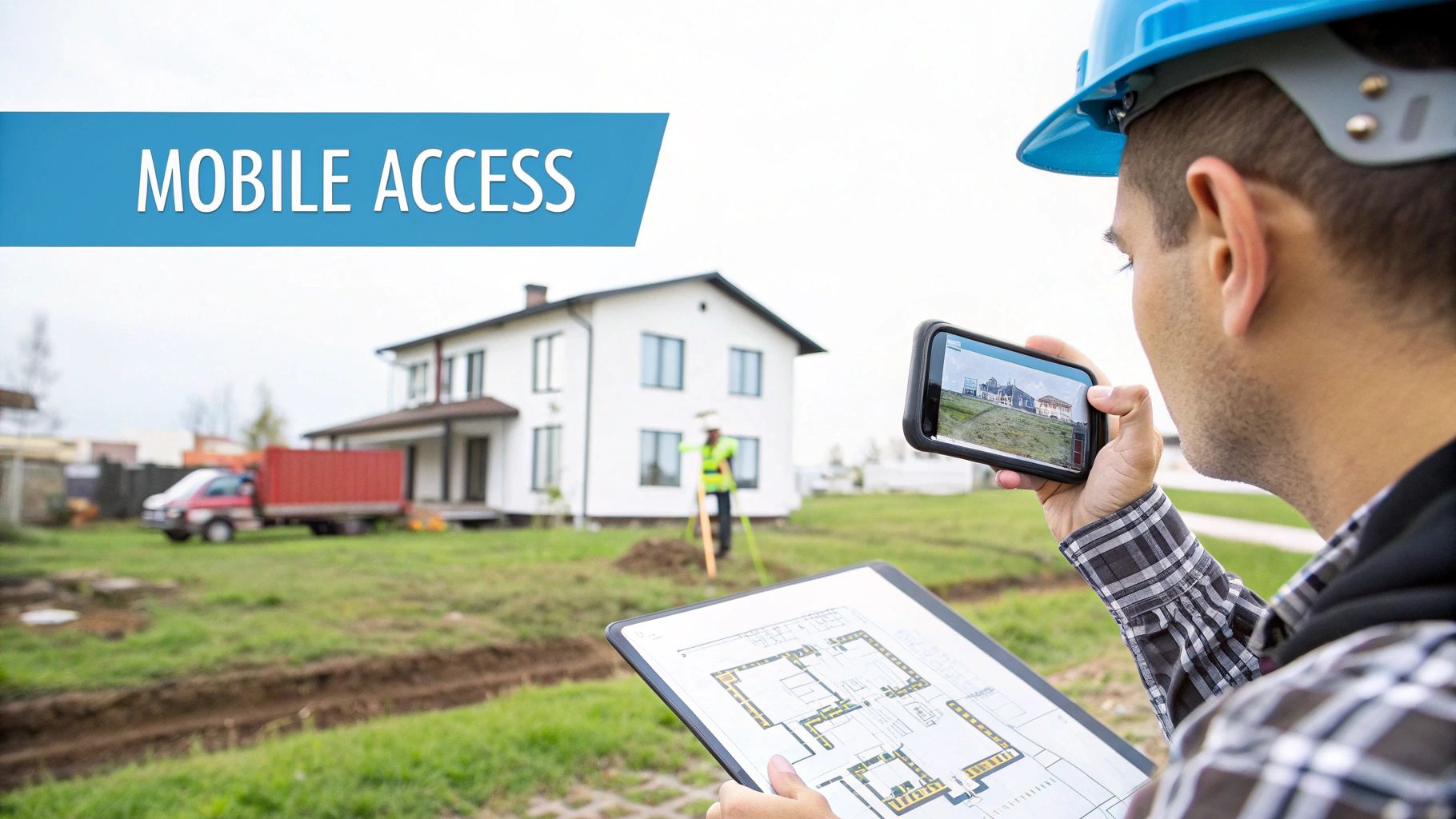
The incredible benefits of a facility management application are a direct result of specific capabilities designed to solve real-world headaches. These are the engine that powers everything from cost savings to a safer, more productive workplace.
The goal is to move beyond simple task-juggling to gain the insight you need to make smarter decisions for the whole organization. Modern platforms pull this off by knitting together several core functions into one intelligent system.
Intelligent Work Order and Maintenance Management
A good application completely overhauls how maintenance work gets requested, assigned, and finished. You can finally say goodbye to messy paper trails and confusing phone calls. A smart system automates the entire flow, from the second a problem is reported to the moment the job is signed off.
The true power here is gaining proactive control. Instead of just reacting when a critical piece of equipment breaks down, you can use data and IoT sensors to see problems coming. This simple switch from a reactive to a proactive mindset can slash equipment downtime by as much as 50%.
A smart system doesn't just manage maintenance tasks; it optimizes them. By prioritizing work based on urgency and operational impact, it ensures that your team's effort is always directed where it matters most, preventing small problems from becoming expensive disasters.
This is what turns your maintenance team from constant firefighters into strategic guardians of your most valuable assets.
Comprehensive Asset and Lifecycle Tracking
Could you say, right now, where every major asset is, what condition it’s in, and its full service history? For most, the answer is a complicated "sort of." Facility management applications turn that into a confident "yes."
By creating a central digital file for every piece of equipment—from the HVAC system down to the fire extinguishers—you get total visibility. This data helps you wring every last drop of value out of your assets.
- Extended Lifespan: Tracking performance data helps you keep equipment running efficiently for longer, putting off expensive replacement costs.
- Reduced Ownership Costs: Monitoring repair costs helps you make data-driven calls on whether to fix it again or replace it, saving thousands.
- Improved Capital Planning: A clear picture of asset health allows you to forecast future spending with much greater accuracy.
This detailed tracking gives you the business intelligence to plan for the long term.
A solid facility management application provides a set of core capabilities that directly translate into measurable business improvements. From streamlining daily tasks to enabling long-term strategic planning, each function serves a distinct purpose.
Core Capabilities and Their Business Impact
| Core Capability | Primary Function | Key Business Benefit |
|---|---|---|
| Work Order Management | Automates maintenance requests, assignments, and tracking. | Increases team efficiency by 28% and reduces response times. |
| Asset Lifecycle Tracking | Creates a central database for all equipment and assets. | Lowers total cost of ownership by up to 20% and improves capital planning. |
| Preventive Maintenance | Schedules routine maintenance based on time or usage data. | Reduces unexpected equipment failures and costly downtime. |
| Space Management | Analyzes and optimizes the use of physical space. | Lowers real estate costs by 10-15% and improves employee experience. |
| Energy Management | Monitors and controls building energy consumption. | Cuts utility expenses and shrinks environmental footprint. |
Ultimately, these functions work together to create a system that's far more than the sum of its parts, providing a holistic view of your facility's operations and performance.
Dynamic Space and Energy Management
How your building uses space and consumes energy has a direct impact on your bottom line. Modern facility management apps give you the tools to get a handle on both. Dynamic space management helps you see how different areas are actually being used, so you can reconfigure layouts and stop paying for real estate you don't need.
The results on the energy front are even more immediate. Buildings are responsible for nearly 40% of global energy consumption, so efficiency is a massive opportunity for savings. By connecting with smart building systems, the application can automatically adjust lighting and climate controls based on real-time occupancy.
To truly push the envelope, these applications are evolving to handle even more complex tasks. A great example is learning to manage and integrate various power sources, which you can explore through this practical guide to distributed energy resource management. These advanced capabilities give you the power to shrink your facility's carbon footprint while making a serious dent in your utility bills.
Choosing Your Strategic FM Software Partner
Picking the right facility management application is a strategic decision that will define how efficiently your operations run for years to come. This isn't about chasing the longest feature list. It's about finding a partner whose solution clicks with your company's core operational and financial goals.
You need to shift your mindset from simply "buying a product" to "forming a partnership." The right vendor will feel like an extension of your own team, giving you the support and expertise needed to see real, measurable value from day one.
Map Your Pain Points to Find Your Solution
Before you even think about watching a demo, the first step is to look inward. What are the specific, day-to-day headaches holding your team back? You need to pinpoint the exact operational struggles you want this new technology to fix.
Are you constantly putting out fires from unexpected equipment breakdowns? Is your team drowning in a sea of paper-based work orders? Or is your biggest blind spot a lack of data on how your physical space is actually being used? It turns out that organizations who clearly define their problems are 73% more likely to choose software that actually solves them.
The goal isn't to find an application that does everything. It's to find the one that excels at solving the problems that cost you the most in time, money, and resources. That clarity will be your best friend during the evaluation process.
Once you've mapped out your challenges, you can start looking at potential partners through the lens of how well they can solve your specific problems. This keeps you focused on real benefits instead of getting distracted by shiny features you might never use.
Scrutinize Scalability and Future Growth
The software you pick today has to work for the company you'll be tomorrow. A system that’s a perfect fit right now could become a major roadblock if it can't scale with you.
Think about your company's five-year plan. Are you planning to open new locations, add buildings, or hire more people? A truly scalable solution should handle that growth smoothly, without a dip in performance or forcing you into a costly platform switch.
- User Growth: Can the system easily add more users without your subscription costs ballooning?
- Asset Expansion: Will the application handle a much larger volume of assets and data as your portfolio grows?
- Geographic Reach: If you expand nationally or globally, does the vendor have the infrastructure to support multiple sites without a hitch?
Failing to plan for scalability can trap you with a system that holds your business back, forcing a painful migration to a new platform just a few years down the road.
Evaluate Vendor Support and Training
Even the most user-friendly facility management application is worthless if your team doesn't know how to use it. The quality of a vendor's support and training is every bit as important as the software itself. In fact, poor user adoption is one of the main reasons implementations fail.
A strong partner will offer thorough, role-based training to ensure everyone feels confident with the new system. Their support shouldn't stop after the rollout, either. Look for a vendor that offers ongoing help and a proactive attitude toward helping you get the most from your investment. This is also a key thing to consider when you need to choose a visitor management system, since the benefit of a professional welcome and enhanced security depends entirely on successful user adoption.
Verify Integration Capabilities
Your facility management software can't operate in a silo. To unlock its power, it must connect seamlessly with other essential business systems, like accounting (ERP), HR, and building automation systems.
Without that connectivity, you’re just creating another island of information, forcing manual data entry that wastes time and creates errors. When you're in a demo, press vendors hard on their integration capabilities. Ask for specific examples of how their app connects with systems like yours. This due diligence ensures you end up with a platform that becomes the central hub of a connected, data-driven operation.
Ensuring a Successful System Implementation
You can have the best facility management application on the market, but it’s worthless if your team doesn't use it. A successful rollout isn't about the technology—it’s about the people. Getting the implementation right means your team will get on board, disruptions will be minimal, and you'll see a return on your investment.
The process comes down to clean data, customized workflows, and solid training. But most importantly, it's about managing change. You need to get everyone, from technicians to executives, genuinely on board with what this new tool can do for them.
Laying the Foundation for Adoption
First, you need a clean start. Trying to migrate messy, outdated data into a new system is like building a house on a shaky foundation. Take the time to clean up your existing asset lists and maintenance records before you import a single thing. This initial effort pays off big time by making sure the system is trustworthy from day one.
Next, you have to customize the application’s workflows to match how your team actually works. If a process in the app is clunky, your team will just find ways to work around it. One study of software projects found that getting end-users involved in the setup can boost adoption rates by over 50%.
A successful implementation isn’t a one-time event; it's the beginning of a new operational culture. The goal is to make the application an indispensable tool that empowers your team, not another administrative burden they have to endure.
Executing a Phased Rollout
Instead of a chaotic "big bang" launch where everything changes overnight, a phased rollout is almost always the smarter move. This approach lets you introduce the system in manageable stages, gather early feedback, and make tweaks along the way.
Kick things off with a pilot program in just one department or a single building. This creates a controlled environment where you can iron out any kinks and, just as importantly, create internal champions who can spread the word about the benefits. The feedback from this initial group is pure gold for optimizing the software for everyone else. For a great example of a streamlined launch, check out our guide on how to setup a visitor management system in under 30 minutes—the principles are surprisingly similar.
Finally, training is non-negotiable. And it can't be a one-and-done session.
- Technicians: Need hands-on, mobile-focused training that shows them how the app makes their jobs easier.
- Managers: Need to learn the reporting and analytics features to start making data-driven decisions.
- Leadership: Needs a high-level overview focused on strategic benefits and ROI.
By investing in clean data, user-focused workflows, a phased rollout, and continuous training, you can ensure your new facility management application truly drives your operations forward.
Answering Your Key Questions
When you start digging into the world of facility management applications, a few big questions always pop up. Getting straight answers is the first step to figuring out if these tools are a good fit for your business and how they can actually make a difference. Let’s tackle some of the most common ones.
What Is the Real Difference Between a CMMS and an IWMS?
It's helpful to think of it like this: a Computerized Maintenance Management System (CMMS) is a specialized toolkit for your maintenance crew. It’s designed to do one job incredibly well—managing maintenance. A CMMS is all about tracking work orders, scheduling preventive tasks, and keeping asset data organized so equipment stays up and running.
An Integrated Workplace Management System (IWMS), on the other hand, is the master blueprint. It handles everything a CMMS does but layers on crucial modules for space planning, real estate portfolio tracking, and sustainability initiatives.
The bottom line: A CMMS is laser-focused on solving maintenance problems. An IWMS takes a broader view, connecting maintenance to the entire workplace ecosystem, from how you use your space to long-term strategic planning.
How Long Does It Really Take to Implement New FM Software?
There’s no one-size-fits-all answer, because the timeline is shaped by the project's scope. A straightforward, cloud-based CMMS for a single building with a small team? You could be up and running in just a few weeks. The goal there is to get core functions live as quickly as possible.
But a full-scale IWMS rollout for a large company with multiple locations and thousands of assets is a much bigger project. These can easily take anywhere from six months to a full year.
Success isn't about speed; it's about being prepared. A phased rollout, where you introduce the system one department or building at a time, is usually the smartest way to go. It keeps the process manageable and helps get everyone on board.
Can This Software Connect With Our Other Business Systems?
Absolutely. In fact, this is one of its most valuable features. Modern facility management applications are built to knock down information silos. They use Application Programming Interfaces (APIs) to talk to the other critical software that keeps your business running.
This creates a single, reliable source of information across the entire organization.
- ERP Integration: Link with accounting systems to get real-time financial reporting on maintenance spending.
- HR Integration: Sync with human resources platforms to keep employee data current for accurate space planning and work assignments.
- Building Automation Systems (BAS): Pull live data from your smart building systems to trigger maintenance alerts based on real equipment performance.
This level of integration is what elevates a simple tool into an indispensable part of your operational strategy.
Managing the building is one thing, but managing the people inside it—from employees to contractors and guests—is just as important. A modern visitor management system from VisitUs creates a secure, efficient, and welcoming front desk that integrates perfectly with your wider facility operations. Find out more at the official VisitUs website.
